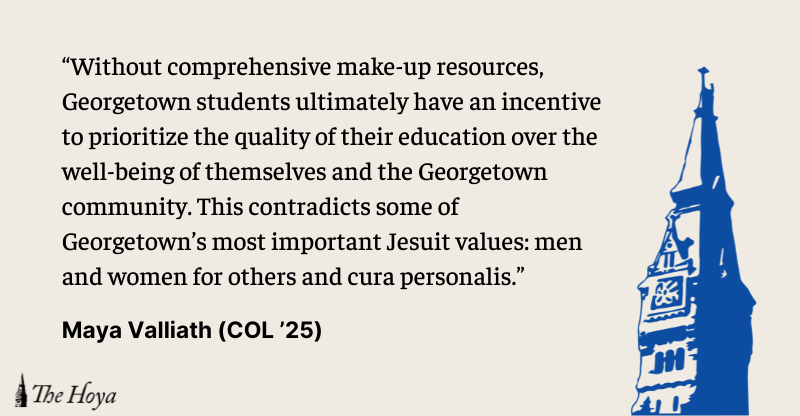After over a year of online learning, Georgetown University’s return to campus has been thrilling, hectic and frenzied. This semester, many students transitioned from part-time course loads held on Zoom to in-person, full-credit course loads. Students now must balance demanding extracurriculars, jobs and social obligations. The transition has not been seamless. The university’s arbitrary illness policies and ineffective resources to make up coursework only make this transition harder.
Protocols for illnesses are unclear. On one hand, Dr. Ranit Mishori (MED ’02), Georgetown’s chief public health officer, has encouraged sick students to stay home, including during this semester’s norovirus outbreak.
“If you are unwell, please stay home and do not attend class or arrive for work,” Mishori wrote in a Sept. 22 email to the student body. “Students do not need a doctor’s note for a medical-related class absence.”
In spite of this advice, faculty are not obligated to make synchronous lectures virtually available to sick students, according to Rohan Williamson, vice provost for education.
“As the semester progresses there will be occasions — illness, family emergencies, or other life events — when it might seem reasonable to request to attend classes remotely,” Williamson wrote in an email to the student body. “You should not expect that you will be able to participate synchronously (i.e., Zoom) in a class designated as in-person, nor should you assume that you may miss class … without an approved reason for doing so.”
Williamson urges students to attend class in person. He also writes that “sharing notes” and “virtual office hours” constitute sufficient accommodation for COVID-19-afflicted students who are unable to attend class.
Countless students find this accommodation inadequate. After falling seriously ill with norovirus, Arianna Nassiri (COL ’24) found that her only accommodation for a certain class was a written transcript of the lecture.
“I tried that for the first lecture and was missing so much from the class discussion so I had to ask a friend to record the lecture on his phone and send me the entire 75 minutes. That week I fell completely behind in my courses,” Nassiri said in an interview with The Hoya.
In this same email, Williamson encourages anyone with COVID-19 symptoms, including a cough, sore throat and runny nose, to stay home. One only needs to watch any Georgetown lecture for about 20 minutes to see that, by this metric alone, most Georgetown students should be self-quarantining.
Even when Hoyas report mild COVID-19 symptoms, it appears these reports are not taken seriously. A few weeks ago, one Georgetown professor, who requested to remain anonymous, filled out the COVID-19 Daily Check-In indicating that he had a cold and sore throat. When called by a university COVID-19 Care Navigator, he was asked if he thought he had COVID-19. He said that after saying no, he was informed he shouldn’t have reported his symptoms at all.
Similarly, Nassiri said she played basketball for over an hour with a student who happened to be positive for COVID-19. When the student received a positive test result shortly after their game, the university did not inform Nassiri of the positive contact or instruct her to get tested.
“I only ever found out because a friend let me know I should get tested,” Nassiri said.
Sifting through the university’s guidance, it seems that sick students should stay home to protect their classmates and professors without any guarantee of quality make-up resources.
Even when a professor makes in-person classes available via Zoom, the virtual experience is hardly helpful. Cameras situated in the back of classrooms capture pixelated, low-quality footage. Microphones barely pick up a professor’s voice, much less those of students, making it difficult to keep up with a lecture and nearly impossible to participate in class.
Without comprehensive make-up resources, Georgetown students ultimately have an incentive to prioritize the quality of their education over the well-being of themselves and the Georgetown community. This contradicts some of Georgetown’s most important Jesuit values: men and women for others and cura personalis.
The university should require professors to provide a remote synchronous option to sick students and train professors to use this feature when a student is ill. The quality of video and audio recordings also needs to improve. Students should be able to clearly hear and see a given lecture over Zoom.
This semester, Georgetown has not given sick students adequate options. Students are left choosing between quality lectures and the safety of their community, a set of options incompatible with our school’s values.
Maya Valliath is a junior in the College.














